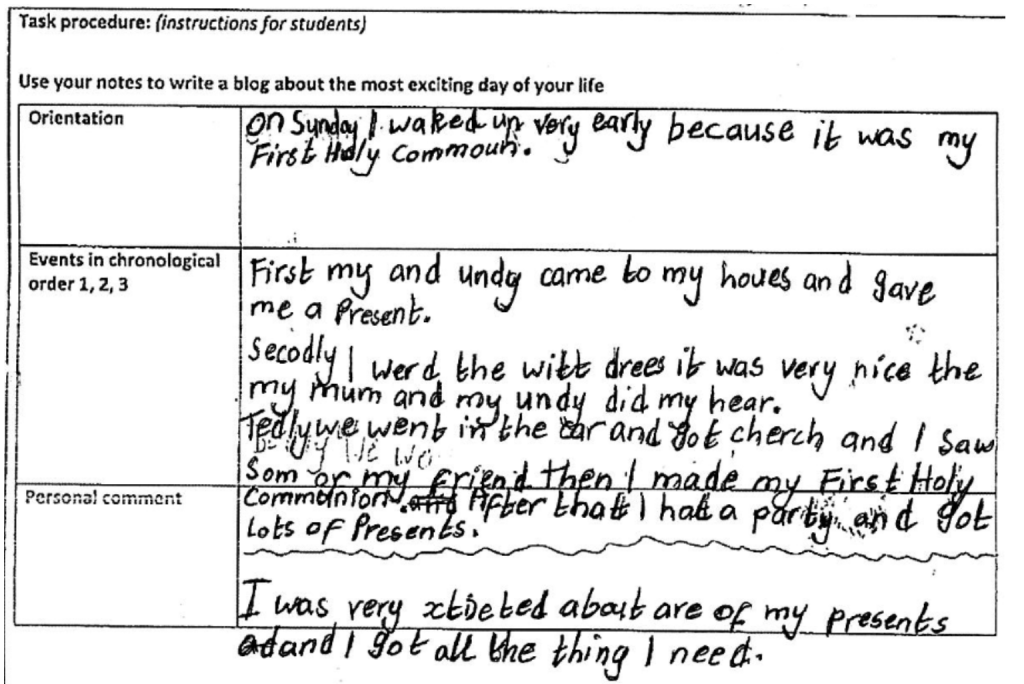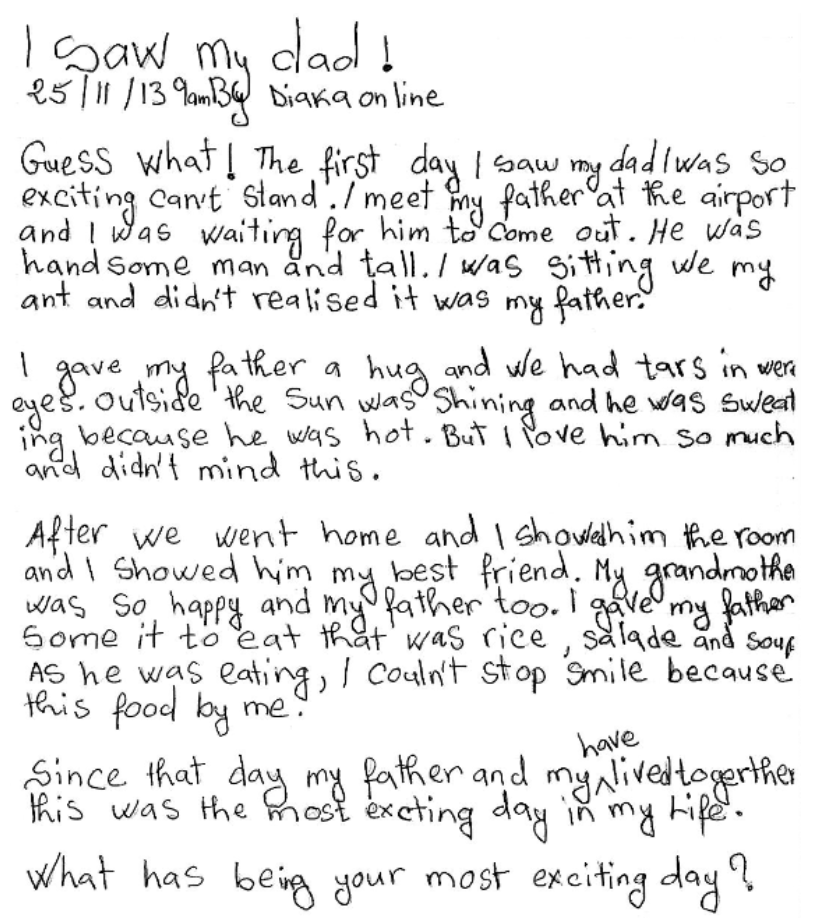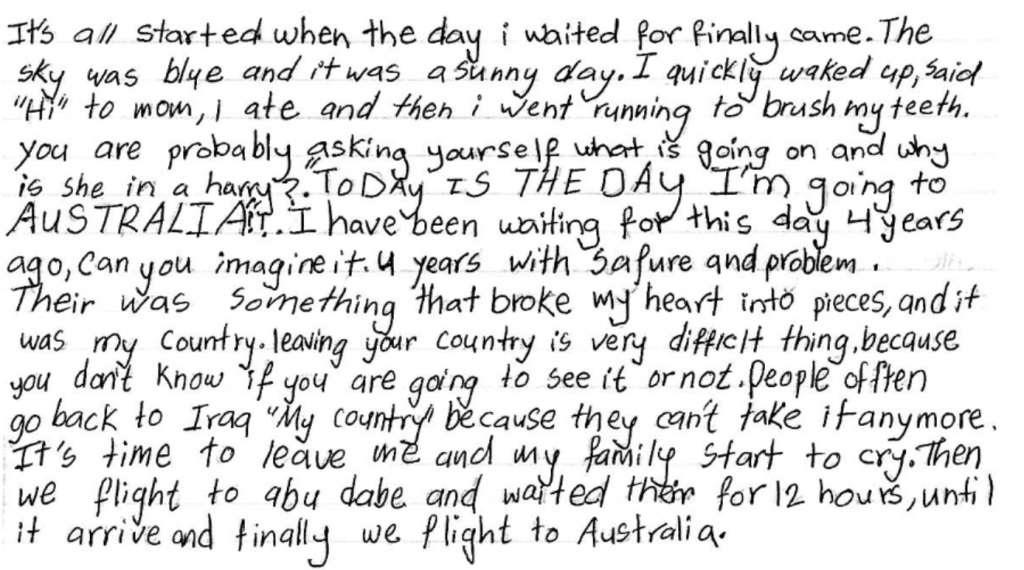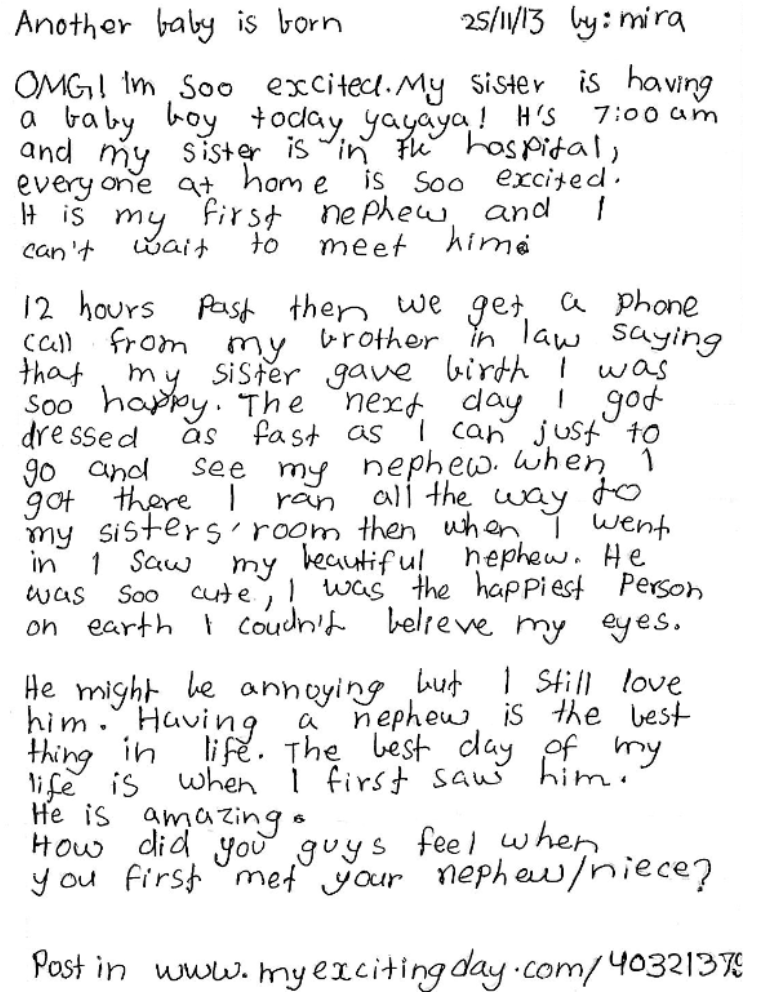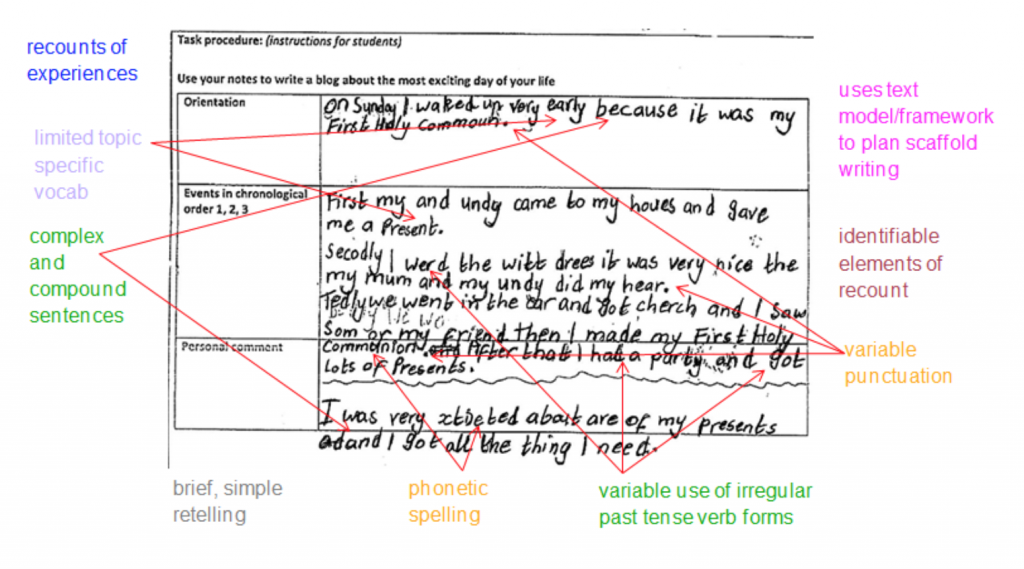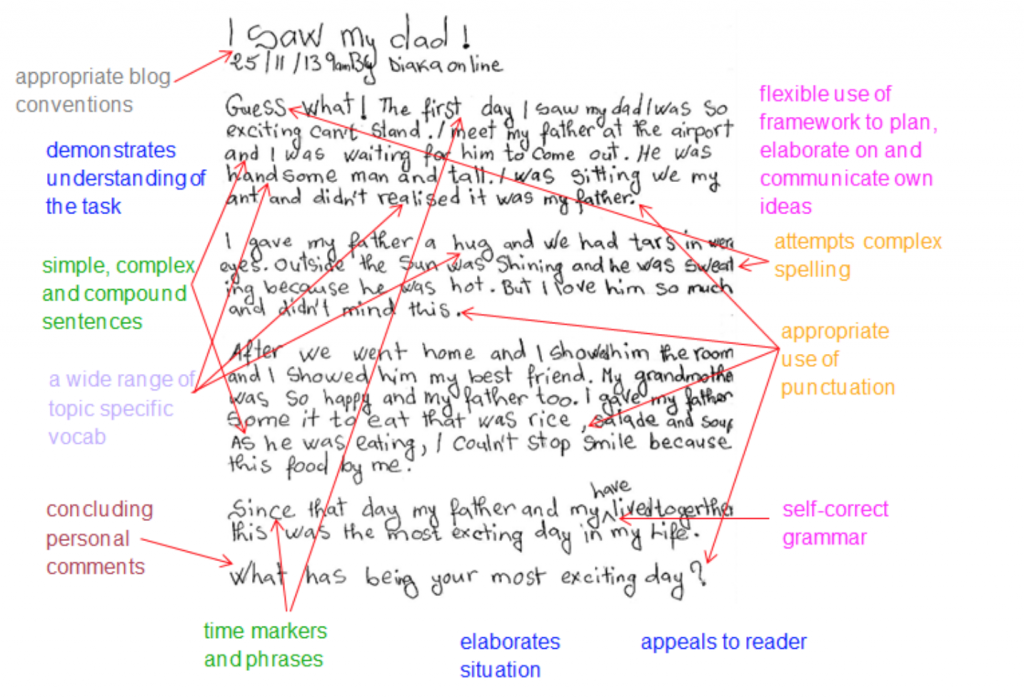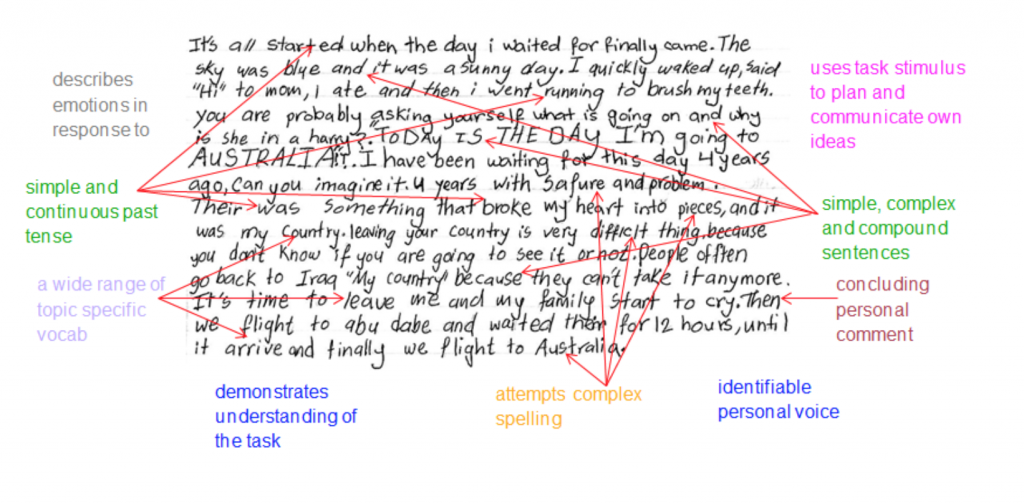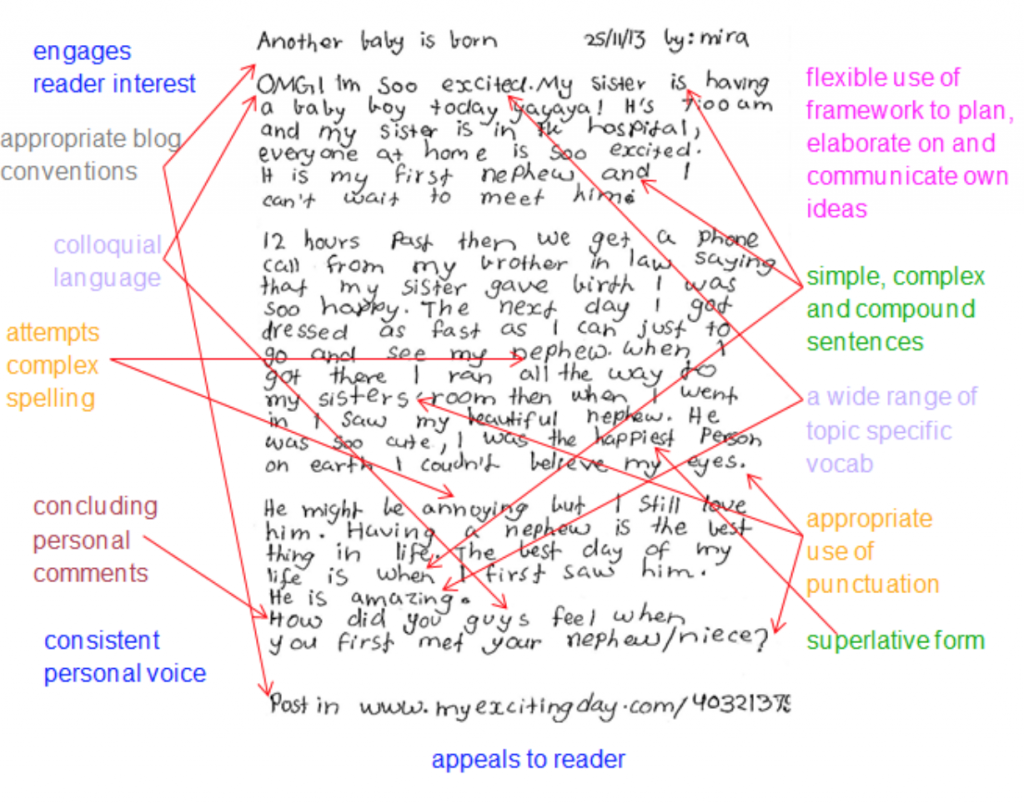15. Blog: The most exciting day of my life
Please click on the toggles below to navigate through information on this assessment task and reveal the links for downloading task materials.
Task details |
|
| Name of writing assessment task | Blog: The most exciting day of my life |
| EAL curriculum level range | B1, B2, B3, C1, C2, C3, C4 |
| Text orientation | Informative |
| Task type | Extended response |
Task specification |
|
| Purpose | To assess students’ ability to write a personal recount. |
| Description | Write a personal recount about the most exciting day of the student's life for a personal diary or blog. |
| Assumed knowledge and description |
|
Learning/teaching context |
|
| Language centre/mainstream class | Mainstream class/EAL Support |
| Subject/key curriculum objectives, outcomes | English |
| Topic/teaching unit | Past experiences and biographies |
| Assessment conditions |
|
| Notes |
|
Task implementation |
|
| STAGE | ACTION STEPS |
| Pre-assessment activity |
|
| Assessment activity |
|
| Post-assessment activity |
|
An explanation of the purpose, nature and use of criteria sheets is available at 4. Using the assessment criteria.
Nature and purpose of the task
A personal recount is an important genre for communication about our own experience and backgrounds. It is often used as a writing topic for EAL learners, as this text type gets students to demonstrate their writing skills without the need to develop an understanding of other content, as it is based on their own experiences, which can be shared and affirmed by writing about them. This task asks students to write about a memorable or significant life event, and so may be linked to writing media that are shared with others, such as a personal diary, a classroom display board of student writing about themselves, or a computer-based blog. So as well as teaching the personal recount genre involved in the task, this task can provide an opportunity for students to learn about the purposes and qualities of different media in which personal recounts may be produced and read. The blog medium is probably of most relevant for older learners what may be learning about internet-based communication and the nature of language used in electronic media.
TEAL Oral Task 1 and TEAL Writing Task 1 'My Weekend' also involve personal recounts. However those cases involve students' recent activities, in contrast to this task which asks for a recount of a memorable or significant event.
Commentary
The samples texts for this task were prepared for students to produce a personal recount for a blog. Sample 1 is highly scaffolded, and it is clear the student's focus is still on constructing the essential elements of the recount. Samples 2 to 4 show an understanding of the nature and form of blogs, and include language appropriate for this, including capitalisation for emphasis and colloquial expressions and abbreviations used in blogs, which is not not considered appropriate in formal writing in more traditional writing formats.
Commentary
The sample shows an understanding of the task and an ability to recount a significant personal experience using relevant vocabulary.
The text shows that the student relies heavily on the provided text scaffold to organise the overall text structure. Events in the text are closely structured according to given sequence markers.
The student mainly uses compound sentences with correct regular past tense verbs but incorrect irregular past tense verbs.
The student uses phonetic but incorrect spelling of much key topic-specific vocabulary.
The student is able to form letters correctly using appropriate sentence punctuation including upper and lower case.
The student is reliant on teacher support and the text framework to accomplish the task.
The marked criteria sheet shows that the student meets most criteria at Level 1 of performance.
The student’s language use in this task is consistent with the descriptions of students at Level C1, Victorian Curriculum F-10 EAL.
Using this assessment to improve learning
(Select the points you think are currently of most importance to the student.)
- Ask the student to read her text and to see if she can spot any spelling errors. Identify the high frequency words that need attention and scribe them for the student: aunty, house, white, hair, some, all (‘are’ in the text: ‘are’ of my presents).
- Perhaps also scribe some of the vocabulary central to her text: communion, to wear/wore, church, excited, secondly, thirdly etc.
- Generally the student has used simple past verb forms well, so see if she can correct the following:
- I waked up
- I werd the white dress
- The student has used some basic punctuation but more could be added, so read the text to the student to see if she can work where additional full stops could go, for example:
- Secondly I wore my white dress. It looked very nice. Then my mum and aunty did my hair.
Commentary
The sample shows an understanding of the task and an ability to recount a significant personal experience in a diary/blog text type.
The text shows that the student is able to describe her experience within a coherent text recount structure. The text is structured by a chronological event sequence, indicated by time markers or phrases, and finishes with a concluding personal comment.
The student uses a mix of simple, compound and complex sentences, as well as a mix of past simple, continuous and perfect verb tenses.
The student uses correct spelling of key topic-specific vocabulary and has general control over sentence punctuation and is able to self-correct grammatical patterns.
The student uses the task as a stimulus to recount her own experience.
The marked criteria sheet shows that the student meets most criteria at Level 3 of performance.
The student’s language use in this task is consistent with the descriptions of students at Level C2, Victorian Curriculum F-10 EAL.
Using this assessment to improve learning
(Select the points you think are currently of most importance to the student.)
- Excited / Exciting
Help the student to differentiate between ‘excited’ and ‘exciting’, ‘bored’ and ‘boring’, ‘interested’ and ’interesting’.
Which examples explain how someone felt inside? Which examples explain a quality that something or someone has. Ask the student to note when we use the ‘ed’ or the ‘ing’ form.
I was excited She was an exciting person
She was bored The lesson was boring
He was interested The book was interesting
Now ask the student to look at her own text and see if she can decide whether to use exciting or excited.
2. Past tense forms
The student has generally use past tense forms well, so see if she can spot some issues with the following examples from her text:
I meet my father at the airport
I didn’t realised it was my father
I can’t stand it
3. Other grammatical patterns that may be worth raising
The student writes quite confidently and may well be able to self correct the following patterns:
I couldn’t stop laughing
talking
crying
Now see if the student can self correct: ‘I couldn’t stop smile’
Because this food ……… by me OR I cooked the food
Since that day my father and I / my have lived together
What has being / been your most exciting day?
Commentary
The sample shows an understanding of the task and an ability to recount a significant personal experience that engages the reader. The text shows that the student is able to describe her experience in a consistent personal voice with details that elaborate her emotions and responses to events.
The text is structured by a build-up and modulation of excitement, personal response and a concluding narrative event.
The student uses a mix of simple, compound and complex sentences, as well as a mix of present simple, past simple and continuous verb tenses.
The student uses correct spelling of key topic-specific vocabulary and has general control over sentence grammar and punctuation.
The student is uses the task as a stimulus to recount her own experience.
The sample shows a text that best fits the criteria at level 3 of performance on the criteria sheet.
The marked criteria sheet shows that the student meets most criteria at Level 3 of performance.
The student’s language use in this task is consistent with the descriptions of students at Level C2, Victorian Curriculum F-10 EAL.
Using this assessment to improve learning
(Select the points you think are currently of most importance to the student.)
- The sample shows the student’s developing control over expressing past and present events in recounting an experience of personal significance. It highlights the student’s need to develop greater control over some verb forms.
- Since, in general, the student has been able to manipulate most verb forms very well, ask the student to identify the issues in the following sentences from her text in relation to 1. the past perfect and, 2. and 3. irregular past tense forms and 4. The use of for/since rather than ago with the present perfect continuous form.
1. The day I …(had) … waited for, finally came
2. I quickly waked up
3. Then we flight to Abu Dabe and finally we flight to Australia
4. I have been waiting for this day …………. 4 years (ago) OR I have been waiting for this day since ………….
Control of verb forms can be developed, over time, by encouraging the student to complete cloze texts which target accurate use of verbs forms to refer to past, present and future time.
- See if the student can explain the difference between ‘there’ and ‘their’
‘their’ or ‘there’?
1. This house belongs to Wendy and Jim. It’s ……… house
2. The cinema is over ………..
3. ………….is someone I want you to meet
4. ………….are a lot of parks in Melbourne
5. I like going to see my grandparents. I love ……..…. little dog Maisie.
- The student has punctuated her text quite well, so see if she can correct the following from her text:
1. It’s time to leave me and my family start to cry
- Vocabulary: Ask the student to explain more about the words 'safure' and 'problem and possibly encourage her to substitute ‘suffering’ for ‘safure’ and ‘anxiety’ for ‘problem’
Commentary
The sample shows an understanding of the task and an ability to recount a significant personal experience that engages the reader in a diary/blog text type. The text shows that the student is able to describe her experience in a consistent personal voice with details that elaborate her emotions and responses to events. The text is structured by a present/past/present time paragraphs reflecting a build-up and modulation of narrative excitement, personal reflection and a concluding question.
The student uses a mix of simple, compound and complex sentences, as well as a flexible mix of present simple, past simple verb tenses. The student uses correct spelling of key topic-specific vocabulary and has general control over sentence grammar and punctuation. The student uses the task as a stimulus to recount her own experience.
The marked criteria sheet shows that the student meets most criteria at Level 4 of performance.
The student’s language use in this task is consistent with the descriptions of students at Level C3, Victorian Curriculum F-10 EAL.
Using this assessment to improve learning
(Select the points you think are currently of most importance to the student.)
The sample shows the student’s ability to write an engaging recount of a significant experience in response to a stimulus text. The competence and sophistication of the student’s writing at both text and sentence levels suggest that the student’s needs lie in the area of consolidating and extending their personal narrative voice in writing.
Narrative voice could be developed by providing the student further opportunities for personal writing using authentic personal texts as stimulus models for their own writing or setting similar writing tasks with key word/concept stimuli.
